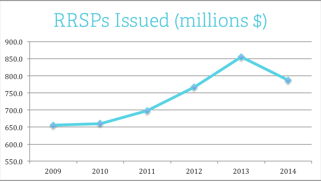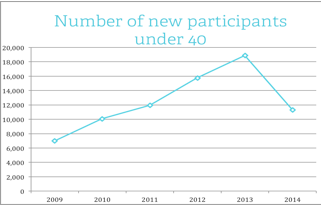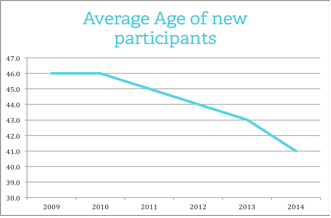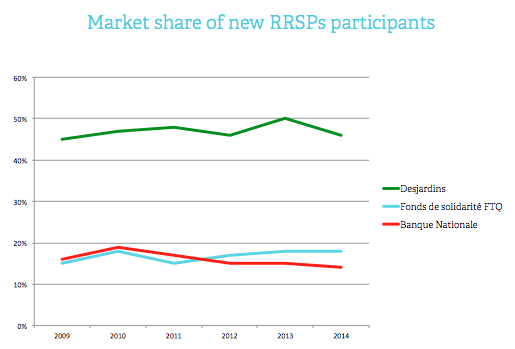The Fonds RRSP: 30% more
Sustained Success (BRONZE)
Client Credits: Fonds de Solidarité FTQ
Denis Leclerc, Executive Vice-President
Patrick Schumann, Executive Director of Marketing
Annie St-Arnaud, Director of Marketing
Gabrielle Thom-Gadbois, Communications Advisor
Nizar Zagdhani, Insight & Research Analyst
Roxane Prince, Digital Director
Sébastien Gagnon, Digital Analyst
Agency Credits: Marketel
Alain Bourgeois, Creative Director
Renaud Seguin, Art Director
Marc-André Vigneault, French Copywriter
Jonathan Rosman, English Copywriter
Jessie Sternthal, English Copywriter
Marie-Pierre Blanchette, Digital Creative Director
Luis Asencios, Digital Art Director
Vicki Marcoux, Insight & Research Digital Analyst
Audrée Couture, Account Director
Marc-André Dionne, Account Executive
Julie Bernier, Media Director
Lina Moussaoui, Media Planner
Section I — BASIC INFORMATION
| Business Results Period (Consecutive Months): | Years 2012, 2013, 2014 |
| Start of Advertising/Communication Effort: | January 16, 2012 |
| Base Period as a Benchmark: | 3 previous years (2009, 2010, 2011) |
Section II — SITUATION ANALYSIS
a) Overall Assessment
The Fonds de solidarité FTQ is a union-based development capital investment fund. Created in 1983, the Fonds strives to cultivate solidarity and allocate the savings (RRSPs) of participating Quebecers towards creating and maintaining jobs while stimulating the Quebec economy. The Fonds’ mission is supported by both levels of government, with a 15% tax credit at both the Quebec and federal tax levels, for a total of 30% in additional tax savings over and above what applies to regular RRSPs.
In 2012, the Fonds faced two challenges:
- The first being that its RRSP owners were getting older. With many of them retiring, the Fonds desperately needed to reach a younger demographic in order to maintain sales and stimulate growth. While it can be challenging to convince people under 40 to save, it is an even harder task persuading them to save for their retirement, since it is not something they relate to yet.
- The second was that most people under 40 only had a vague idea of what the Fonds was and virtually no idea of the benefits it provided.
A big challenge was ahead of us.
And yet another hurdle surfaced in the fall of 2013, the FTQ and the Fonds de solidarité FTQ came under intense media scrutiny during the Commission Charbonneau in Quebec as allegations of scandals and questionable practices surfaced. It is against this backdrop and resulting loss in investor confidence that the Fonds embarked on its 2014 RRSP campaign.
b) Resulting Business Objectives
In the face of stiff competition from Desjardins and Banque Nationale, the two major players in the RRSP field in Quebec, we needed not only to differentiate the Fonds from these institutions, but also make its RRSP attractive to young people by making potential investors under 40 aware of the exclusive benefit of a Fonds RRSP: an additional 30% tax savings.
A number of quantifiable core business objectives were identified, including:
- Increase the sales of RRSPs, specifically in the 30 to 40 year old group
- Increase the number of new RRPS participants, specifically in the 30 to 40 year old group
- Decrease the average age of new Fonds’ participants
- Increase the Fonds’ market share
c) Annual Media Budget
$2 – $3 million
d) Geographic Area
Province of Québec
Section III — STRATEGIC THINKING
a) Analysis and Insight
Most financial companies that advertise RRSPs sell the benefits one will reap once retired. However, this message does not resonate with most young people. Young Quebecers believe that RRSPs are not attractive and not necessary for them. They are perceived as a long-term investment and their priority is to invest in their near future. So how could we transform a complex retirement-oriented savings program into a must-have instant cash return that would be appealing for the younger generation?
To tackle this challenge, we needed to start by understanding why only 53% of young Quebecers were investing in an RRSP. Through research, we uncovered two key insights:
First, we learned that the confusing language of RRSPs was a huge barrier for young, would-be investors. All communication around RRSPs was sending cues that this was something people should worry about at 45 or 50… not at 30.
Second, we learned that while the Fonds is the only RRSP offering 30% more tax savings, it was an advantage that our target did not understand. When explaining the benefits to our focus groups, everyone around the table agreed that it made more sense to get a Fonds RRSP, but they needed an explanation as to how it worked.
The overarching strategy therefore became to illustrate the difference between a regular RRSP and one from the Fonds de solidarité FTQ using simple comparative elements. The whole idea was to visually demonstrate that you get more with the Fonds’ RRSP.
b) Communication Strategy
We built our communication strategy in three phases. These phases were rolled out across three years: 2012, 2013 and 2014.
Phase 1 – Informing our target about the Fonds’ RRSP (November and December)
We used this first phase to educate our target on the benefits of investing in a Fonds’ RRSP in the period leading up to sales.
Phase 2 – Hard push on selling RRSPs (January and February)
During the two-month RRSP period, we incited people to take action by communicating the 30% advantage across all mass media channels with a sense of urgency.
Phase 3 – Convincing young adults to register for the Fonds payroll savings program (March and April)
The third phase was to remind those who had not contributed to an RRSP that year, that is was never too late to do so by enrolling themselves in the Fonds’ payroll savings program. This way, they would not have to think about it the following year.
Section IV — KEY EXECUTIONAL ELEMENTS
a)Media Used
Television (English and French)
- 15-sec. and 30-sec. spots
Print (English and French)
- ½ pages in daily & weekly newspapers
Radio (English and French)
- 30-sec. spots
Out-of-home
- Regular and digital billboards
- Subway stations
- Bus shelters
- Bus wrap
Online (English and French)
- High impact & standard banners
- Home page takeovers
- Mobile
Microsite
Emails (English and French)
Business to Business
- Print and online selling the payroll savings program to employers
b)Creative Discussion
The creative platform reminded young people that 30% more in tax savings is a 100% no-brainer. Why would you want less when you can have more?
Explaining the advantages of the Fonds in a simple, accessible and entertaining way was key to driving enrollment. Our goal with each execution was to demystify the subject and remove the fear factor.
Moreover, to stand out from the typically more traditional competition, we used a light, funny and innovative tone that would certainly resonate better with the demographic we were targeting.
The television and radio commercial told a fuller story with many small examples of what getting more means.
The print, out-of-home and online elements extended the creative platform by demonstrating the 30% advantage with day-to-day objects shown the usual way versus the Fonds’ way.
A microsite, using the self-explanatory URL “30percentmore.com” , was also developed in order to redirect our campaign traffic.
We also wrapped extended buses throughout the city of Montreal to play on the fact that they were 30% longer.
We used emails to remind existing Fonds participants that they were getting more with the Fonds and to encourage them to subscribe again this year.
Lastly, B2B creative was also developed in order to speak to employers about the importance of offering a payroll savings program to their employees
c)Media Discussion
We built our media strategy around the three communication phases.
Phase 1 – Informing our target about the Fonds’ RRSP (November and December)
During this phase before the RRSP season, television news and public affairs environments were targeted in order to reach a maximum audience likely to be receptive to the Fonds’ message and understand what a Fonds RRSP really is. This audience was more inclined to be interested in learning about the financial benefits of such a product. Since fall is a busy television season, we leveraged the high ratings while avoiding the Christmas chaos. It was also of course important to leverage the back-to-school period, which provides the highest ratings of the year and precedes the RRSP season. The campaign therefore launched during the most watched shows in Quebec.
Phase 2 – Hard push on selling RRSPs (January and February)
This phase focused on consumers that intended or were likely to purchase RRSPs. Since the end of February is the deadline to purchase RRSPs, we concentrated our campaign from mid-January to late February. We opted for a reach strategy and were able to get to 95% of our target.
Since the last two weeks of February are always those with the most RRSP sales, an increased presence in the market was simply necessary. In order to further reinforce the Fonds’ presence, we purchased premium placements such as TV countdowns (last spot before the beginning of a show), helping the Fonds to differentiate itself from other advertisers and, most importantly, from other RRSP sellers.
To reach a younger target and given the evolution of media consumption, we pushed the video content online and on tablets in the form of pre-rolls, which could also be found on TV stations and news websites.
Phase 3 – Convincing young adults to register for the Fonds’ payroll program (March and April)
For this third phase, we opted for a digital-only strategy to encourage young investors who had missed the RRSP deadline to subscribe to an automatic pay deduction for the following year. This program allows them to contribute to an RRSP by making small regular payments throughout the year.
As illustrated by these three phases, the media strategy was to start the campaign off slowly, then build a greater sense of urgency as the deadline for contributions approached. As a friendly reminder to Quebecers to invest with the Fonds, we launched a five-day countdown campaign that ran during the last week of the second phase. This offensive consisted of OOH digital billboards and print ads that displayed the daily date change, provoking people to make their investments. During the final 24 hours, a live countdown ran on digital portals and humorous radio commercials hit the airwaves. All elements reminded Quebecers that the deadline was fast approaching.
Lastly, to increase the Fonds’ exposure in relevant environments, we sponsored financial segments during popular morning TV shows. These sponsorships were negotiated to include 300-sec. spots, leaderboards, animated banners and integration into the shows content, during which an expert outlined the advantages of investing in RRSPs.
Section V — BUSINESS RESULTS
a) Sales/Share Results
A 20% increase in the number of RRSPs issued during 2012, 2013 and 2014 compared to the three previous years.

A 36% increase in the number of new RRSP participants acquired during 2012, 2013 and 2014 compared to the three previous years.

A 58% increase in the number of new RRSP participants under 40 acquired during 2012, 2013 and 2014 compared to the three previous years.

Average age of new participants went from 46 years old in 2009 to 41 years old in 2014.

A 3% increase in the market share, moving the Fonds into second place in the Quebec RRSP market, a first in its history.

b) Consumption/ Usage Results
c) Other Pertinent Results
d) Return on Investment
Section VI — CAUSE & EFFECT BETWEEN ADVERTISING AND RESULTS
a)General Discussion
The campaign was successful beyond everyone’s expectations. Not only did the above results exceed client objectives, but the strategy also paid off in other ways. The 2012, 2013 and 2014 RRSP campaigns have been the fourth, second and third best-selling campaigns in the Fonds history.
These great results were even more surprising during the 2014 campaign, as the campaign kicked off just after the Commission Charbonneau, during which the media portrayed the Fonds in a very negative way for many months. We were pleasantly surprised to see that the campaign helped the Fonds maintain its position in the market and drive sales, resulting in its third best-selling campaign ever
b)Excluding Other Factors
Spending Levels:
It is important to note that no changes were made to the Fonds’ basic offer. The Fonds’ mission (to foster employment in the province via direct investments in local businesses) and the additional 30% tax exemption afforded to its shareholders have remained unchanged since the fund was inaugurated over 30 years ago.
Spending Levels:
Annual media spend and production budget were similar in 2009, 2010, 2011, 2012, 2013 and 2014.
Pricing:
There was no unusual price discounting during the campaign.
Distribution Changes:
There were no major distribution changes.
Unusual Promotional Activity:
There were no unusual major promotional activities.
Other Potential Causes:
There are no other potential sources of business change.